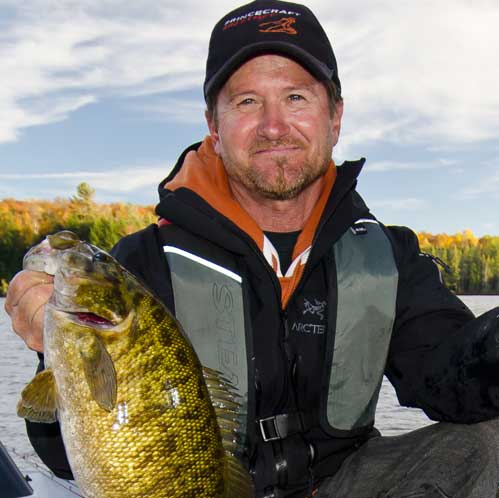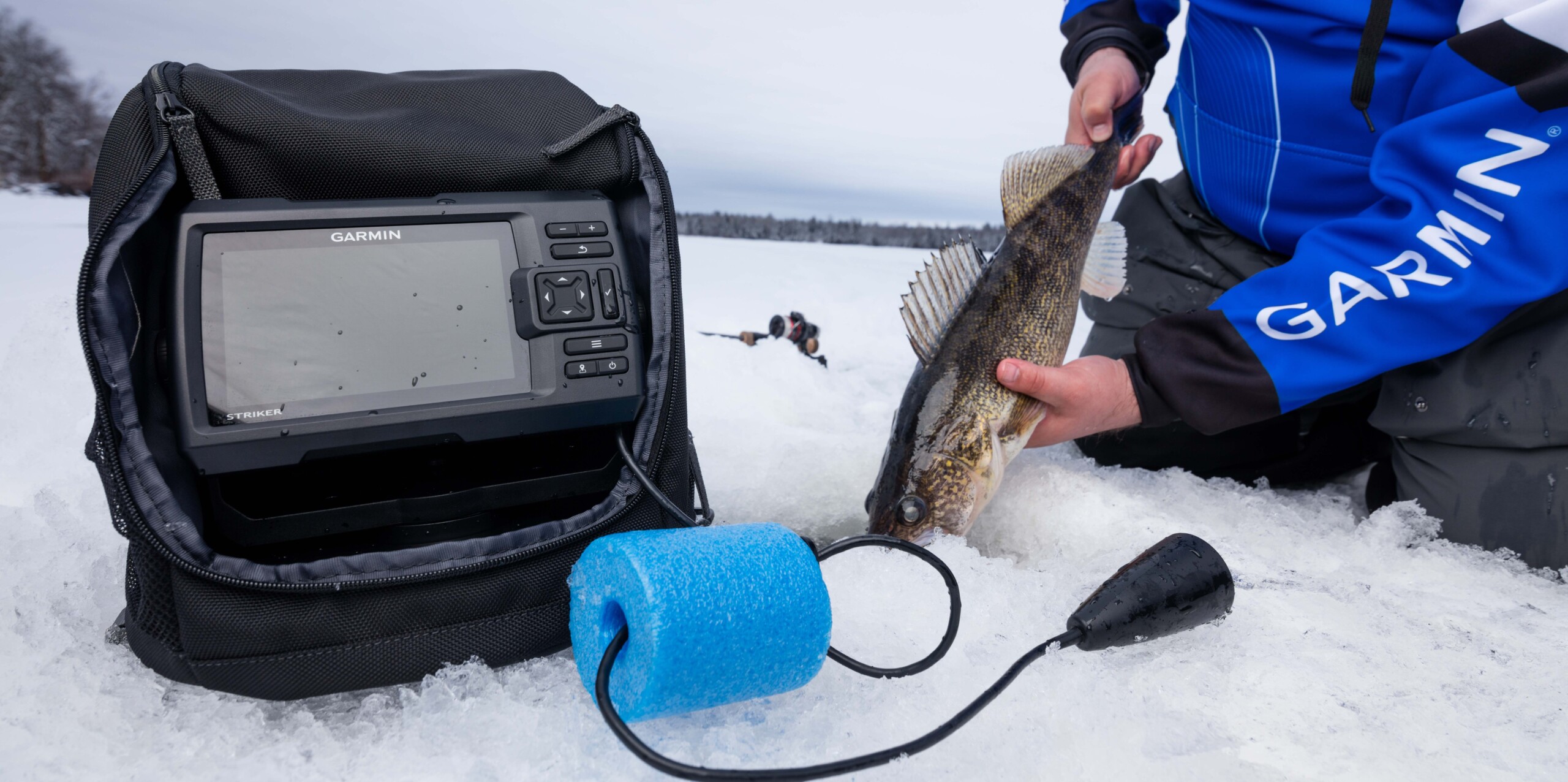Sponsored by Garmin
We thought we would like to give you some “current” recommendations as to 5 ice fishing Garmin units and 5 reasons as to why we feel they are right for you.
In order from least expensive to most expensive, here are the Garmin units we recommend this ice fishing season.
Unit #1
This compact unit is a great entry-level ice fishing sonar which also suits those going on long trips to a back lake where size and weight are an issue. Not only is this a fishfinder, but it is a GPS as well. And as a bonus, installed with Quickdraw, it can store up to 2 million acres of maps with 1’ contours.
Tip #1
With a light, compact unit like the Striker Plus4, a good idea is to have a thermos of water available at all times. When moving around on the ice while looking for new fishing areas, pour a bit of water on the ice’s surface, and then place the ice transducer in the puddle. Barring all kinds of surface snow, the signal will shoot directly through the puddle and the ice, showing a great bottom image. No need to drill.
Unit #2
The Striker 5 is a step up from the Plus 4 in size as well as features. The “vivid” aspect allows anglers to set up colour pallets that suit their personal preferences.
Tip #2
In carrying on with the Vivid pallets, you wouldn’t believe how much of a difference in a long day’s fishing that the perfect screen for you will make. We do it with the units on our Princecraft all the time. We sit out on the water, run through all the various screens (traditional, down, side etc), and dial in what we feel is best suited for our minds. This builds confidence as well as gives the angler something that they “WANT” to look at, and not just something that they occasionally glance at. That’s huge!
Unit #3
Now we’re gaining traction. The above is in the EchoMap Ultra High Definition lineup… absolute state-of-the-art fishfinders as well as GPS’s. It is still priced well within the “average” angler’s budget and it packs a serious punch when it comes to performance. Ang and Pete have been running various EchoMap units for years now and cannot say enough about this series.
Tip #3
This is a fantastic “double-duty” unit in that you purchase the ice kit but can also use it all year long. As it comes, anglers can simply pop that unit anywhere into their boat, drop the transducer over the side or stern, and get an instant open-water reading. It may not be as good as a fully rigged, permanently mounted system, but it is definitely a bonus on a fly-in or small back-lake adventure.
Depending on the unit (actually any portable Garmin’s), you may be able to purchase a second “boat” transducer with the suction cup mount and have a great all-open-water-season setup.
Unit #4
The 73CV is different from the above in having a larger 7” screen and utilizes Garmin’s original Panoptix technology along with a traditional transducer.
If you are yet to be able to afford the full-blown LiveScope setup, this is a great alternative. The PS22 Panoptix forward and down transducer essentially does the same as the LiveScope transducer, but with less detail. But don’t be fooled, the 22 is a monster in power and once used to it, you’ll become an expert at picking off fish in no time.
Tip #4
Take advantage of the two transducers that you “should” be using with this kit. In doing so, you can utilize the flasher, traditional, down (sometimes), and the Panoptix screen.
Finally, the pièce de résistance, the masterpiece, the ultimate ice fishing portable package, Garmin’s LiveScope Bundle. This is one slick package. You have heard us harping about the LiveScope technology basically taking over our fishing lives. Well, that goes for the hard-water as well. We will say right here and now, this is a hefty bundle. Even with a larger capacity, lightweight, lithium ice-fishing battery, you still know you’re carrying this baby… but that’s only if you are walking. Most ice anglers that have invested in this package also have an ATV or a snowmobile to ease the pain and broaden their range of travel on the ice.
Tip #5
We swear that this “LiveScope” technology is something from the future. To be able to punch a hole in the ice, drop the LVS32 transducer on the packaged ice fishing pole into that hole, spin it around 360 degrees, and see fish 40’ away (as an example)… come on! And then, to walk over that 40’ distance to the area you saw those fish, then punch a new pair of holes (one for the transducer and one for your bait) and watch the fish “EAT” your offering… once again we say, COME ON!!!
FYI…
If you want to get your hands on a new Livescope unit but don’t want to shell out the cash, Fish’n Canada is currently hosting a contest where two lucky entrants are going to walk away with a FREE unit! Check out the link below to see how you can get in on the action.
Conclusion
We very much agree with many anglers in their statement that “ice fishing sure isn’t what it used to be”. But who says you have to bring all the bells and whistles. It’s your choice as to if you want to do it old-school.
Us, however… no-sir-ee, we want the bells and whistles. We want the latest technology that money can buy. We want to take advantage of this new age of fishing. To us, it beats the hell out of sitting over a single hole, all day long, “freezing” our butts off, while waiting for a fish to maybe bite.
If they’re not biting, then at least we can see what they’re doing!






9 Responses
Never had the chance to use this kind of technology, Would be nice to give it a try.
Awesome Technology Now-a-Days
Garmin is Top’s
Enter Hear>>>https://swee.ps/cBCRFR_VuZFiLp
I haven’t dropped my LiveScope transducer through the ice yet, but will be doing it very soon. Purchased the bundle November 30th. Updates are all done using Active Captain app. It worked great.
Excellent unit
Would love to try this technology. Seems like a game changer on those tougher days
Good to hear somebody has been listening closely to this old Seadog! There is certainly no confusion when it comes to the specific facts of sound propagation and electromagnetic wave transmission. Fish Finders and their Radar capabilities certainly have a multitude of options no matter what unit you engage.
Fish are no different than any other submersible object. Most are in constant motion and take on different aspects throughout the water column. Locating your target in the manner noted in Pete’s article, is just a matter of what is referred to as a “radar sweep”.
It would be an added bonus it these things could correlate range, speed and aspect of target in degrees.
Up periscope!
You missed one. The Striker cast GPS from Garmin. It’s a wireless transducer sending the signal to your phone, or tablet. So it is small, and light for backpacking in to remote lakes. My set up is very workable. I might step on some toes for mentioning fishing tackle not partnered with Fishing Canada, but here I go. The heart of the system is a Rapala sportschair 30 backpack. It has a large main compartment, with two side pouches, and a small pouch on the front. On the back is a folding camp chair. It’s tall enough to sit comfortably all day long. Inside I put my sonar, a deeper pro, it goes in a side pouch, with my jar soft plastic baits In the main pouch I have my tablet, a telescopic ice fishing rod. It’s a modified telescopic Kast King. I built it myself with three other rods. Just to get the right floating guides. My Milwaukee18v fuel cordless drill, and battery. A small tackle pack, and pliers are in the front pouch, and the other side pouch has a whistle, and a weighted throwing line. Let’s don’t forget safety. I have a soft sided rod locker. Surprise, no rods, but a 6, or 8 inch auger. I plan on replacing the Deeper pro with the Garmin unit for these reasons. It has mapping capabilities with 1 foot increments on contour lines. Way point marking, for getting back to good spots. I used to mark the ice with a big X, but could never find them on new ice. LOL It has an small cone for ice fishing, and a large cone for open water. The GPS, and lake mapping can help you find new spots, or return to last years spots. It has a longer battery life than my unit, and it is half the price I would have to pay for a Deeper sonar upgrade. The upgrade has a CHIRP transducer, but I can live without that. The important lesson of sonar use is this. If you cut a hole, and aren`t marking fish, you should move. That’s the most important function of the sonar. It tells you if their are fish below you. They have a unit to hold the Deeper sonar to your transom, so you could easily create some maps while you are out fishing. These are on Ebay, and maybe could be modified to hold the Garmin unit. So there’s number 6. My system is good for getting in to small ponds, and lakes with poor access for snowmobiles, or four wheelers. Think Brook Trout ponds. I can hike all day with my backpack(chairpack30) and auger locker. Chairpack 30 is $90, rod locker is $30, auger is $80, Milwaukee fuel drill is kinda expensive. It’s $300. But it’s the best for the auger. My deeper pro was $300, but the Garmin is on sale for $209. My telescopic, considering I used 4 rods would be around $120. Well worth it to have a ice rod that fits in my backpack. It also rides on the smallest of snowmobiles, on your back, of course, without having to pull one of the ice sleds. Makes it easier on tight trails. Get something like this together, and don’t forget the Garmin Stiker cast GPS sonar. Keep your lines tight.
I’m a Garmin fan from a way back!
Steve